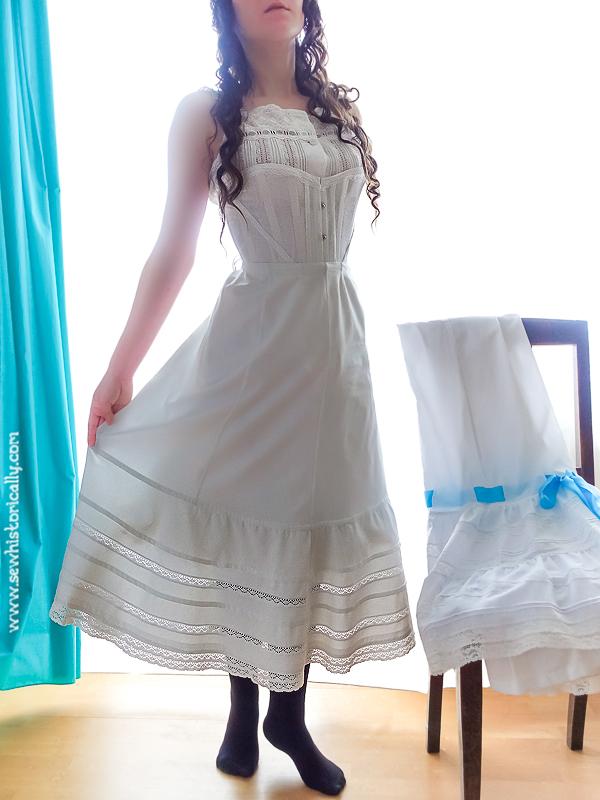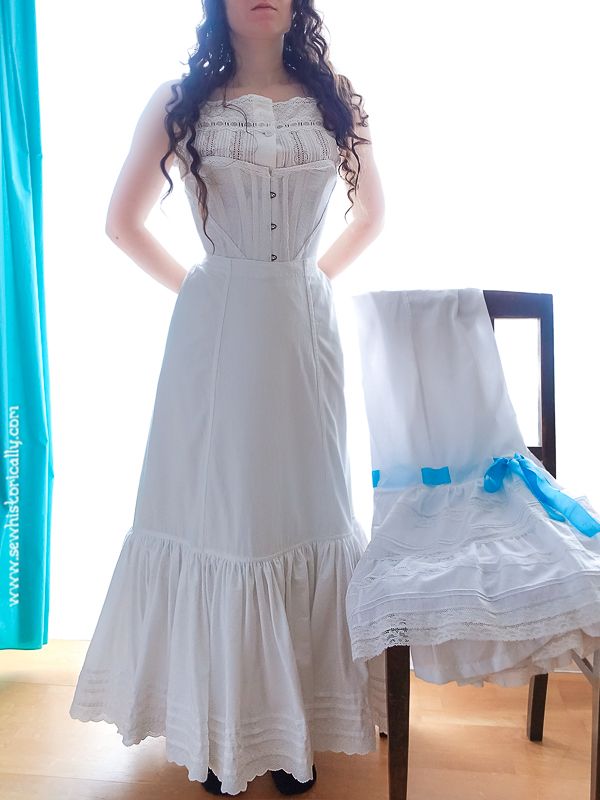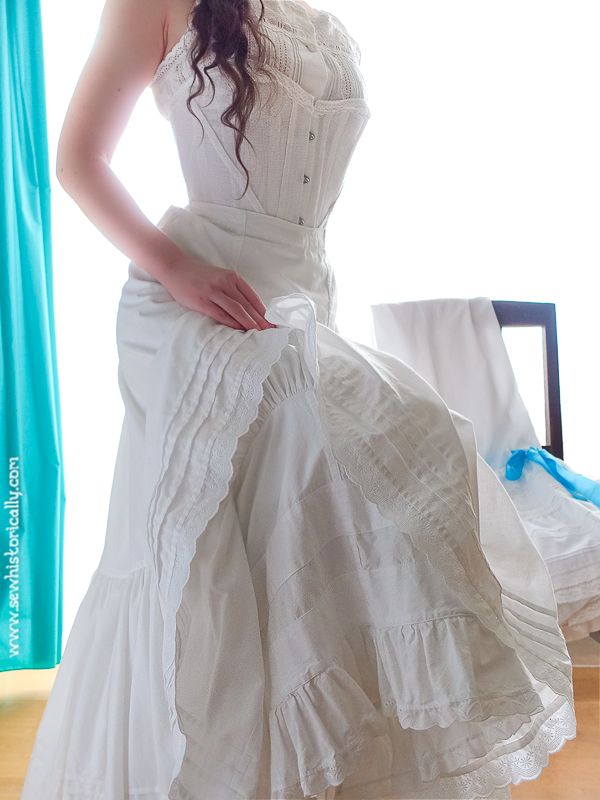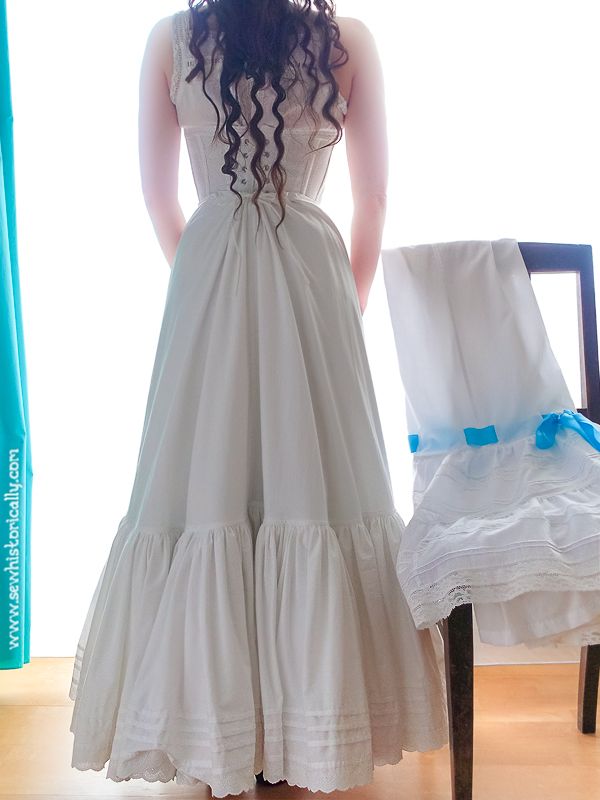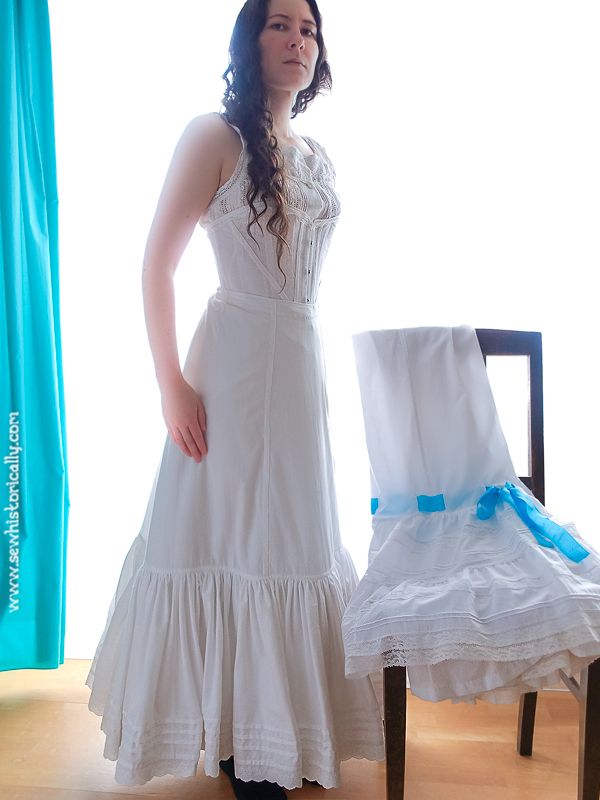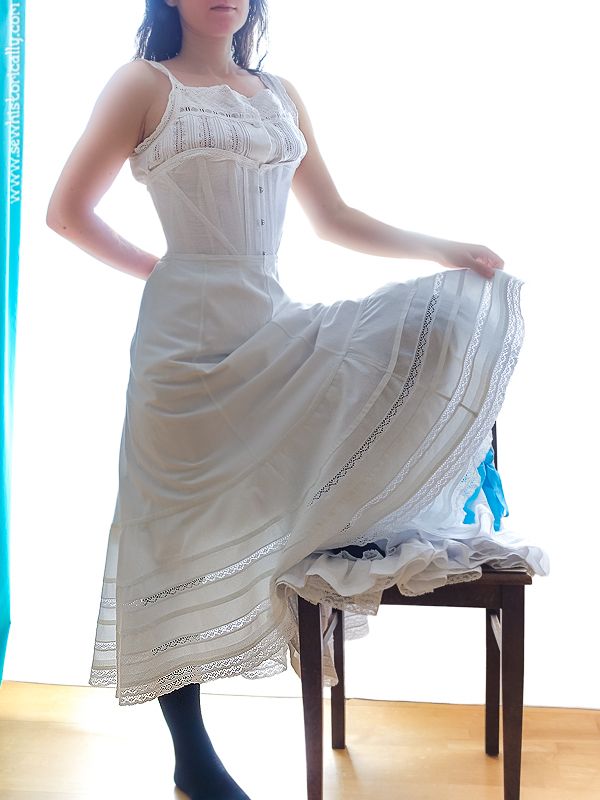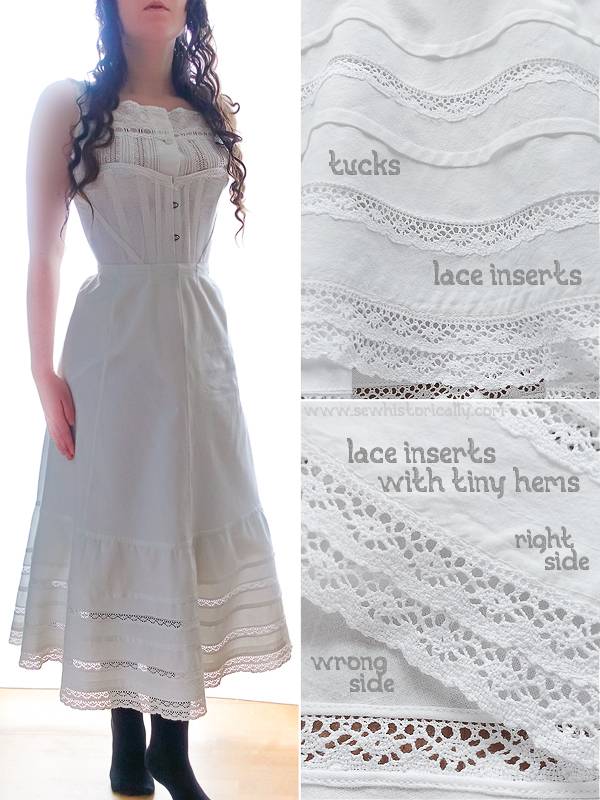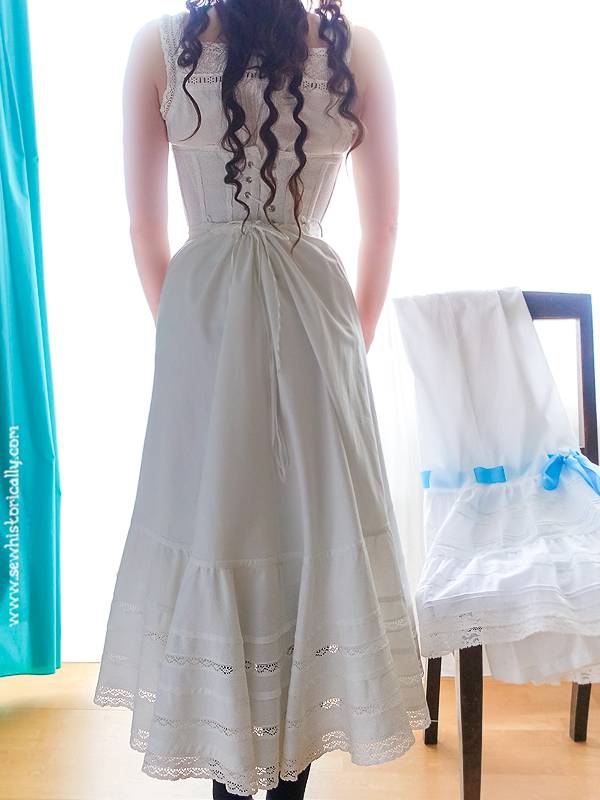A couple of years ago I made two plain Edwardian petticoats. But one of the petticoats wasn’t 100% historically correct and the other (longer) petticoat hadn’t enough width around the hem. So I decided to give both petticoats a makeover because the fabric was still good and strong.
Long Edwardian Petticoat Makeover
Problem 1: Too Small Hem Circumference
The hem circumference of my long Edwardian petticoat was too small for the wide flaring skirts of the early Edwardian era. One of the functions of Edwardian petticoats was to support the hem of the dress skirt. But my small petticoat with only a dust ruffle at the hem didn’t do that. But I was lucky that I had cotton fabric with a similar weave and fabric weight in my stash.
Solution: Add Another Ruffle
Early Edwardian skirts and petticoats were very wide around the hem. So I used all of the cotton fabric from my stash to make the ruffle as voluminous as possible! I added the new wide ruffle on top of the petticoat and dust ruffle, so there are two fabric layers at the hem – typical of Edwardian underskirts.
‘An underskirt may be finished with both a flounce and a dust ruffle.’ (A Manual Of Home-Making, 1919). ‘A dust ruffle about 4 inches deep is generally put on to prevent wear, while the flounce, which can be any depth, is added for flaring as well as beauty.’ (Text-Book On Domestic Art, 1911)
The following antique Edwardian petticoats were the inspirations for my eyelet lace petticoat: Edwardian petticoat with tucks & eyelet lace edging and this Edwardian slip at the MET.
The hem circumference of my new top ruffle is 900cm (355″). I decorated the ruffle with 3 tucks and cotton eyelet lace edging.
‘A white cotton underskirt with a straight gathered flounce may be finished with […] tucks and embroidery edging’ (A Manual Of Home-Making, 1919).
‘Tucked flounces or bands of the same material may be used for simple decoration’ (Clothing For Women: Selection, Design, Construction, 1916). ‘Ruffles may be made any depth desired, hemmed, and simply edged with appropriate lace or embroidered edging’ (Clothing For Women: Selection, Design, Construction, 1916)

Self-Fabric Bands
I also stiffened the petticoat under the new ruffle with two self-fabric bias bands similar to this, this or this Edwardian petticoat.
‘Bias bands of material make effective trimmings for undergarments. Rows of double bands may be used to decorate the lower edge of utility petticoats’ (Clothing For Women: Selection, Design, Construction, 1916).
I love how the petticoat turned out – even if it’s really heavy now! But the Edwardian petticoat is now finally wide enough to support the wide skirts of the early Edwardian era.
Problem 2: White Isn’t Always White
Apart from the too small hem circumference of the petticoat, there was another problem: the shade of the petticoat, new fabric and lace didn’t match!
Even if you buy white fabric or lace, they usually have different shades of white: bluish white, pure white, offwhite or cream white – all are sold as white. I hate that because cream white fabric and bluish white lace never looks good together! And that was the problem with this petticoat: the petticoat fabric was cream white, the fabric for the ruffle offwhite and the lace bluish white!
Solution: Bleach & Coffee
Therefore I bleached the petticoat and the fabric for the ruffle about three or four times. By the way, I usually never use bleach because it makes fibers weak and reduces the lifespan of the fabric. But there was no other alternative than bleach.
And to make the bluish white lace more offwhite, I soaked it in a weak solution of coffee. I used coffee instead of black tea because coffee gives cotton a more yellowish color. I also ironed the lace on high heat after washing because this also turns cotton more yellowish. And finally, the petticoat, the fabric for the ruffle and the lace were about the same shade of white!
‘f you want to color white lace […] cream […] put them into a cup of cold coffee and let them stay about half a day.’ (Mrs. Owens’ Cook Book, 1903)
Short Edwardian Petticoat Makeover
Problem: Not Historically Correct
The problem of the shorter Edwardian petticoat was that it wasn’t historically correct. It was the first Edwardian piece of clothing I made many years ago and therefore I simply zigzagged the seam allowances. Aside from not being historically correct, zigzagged seams look untidy and are difficult to iron. So it bothered me and I decided to refashion the petticoat so I would like it again.
The Edwardian Petticoat Makeover
Therefore I took the flounce and waistband off, finished all seams with flat felled seams, added a new waistband and re-attached the circular flounce with a historically correct receiving tuck.
Related: How To Sew A Receiving Tuck & 4 Other Historical Ways To Attach A Ruffle
‘The circular flounce adds fullness to the edge of the skirt without bulk at the top of the flounce.’ (Clothing For Women: Selection, Design, Construction, 1916)
I also added 4 rows of cotton bobbin lace and 2 tucks along the hem inspired by this Edwardian slip at the MET.
‘A white cotton underskirt with a circular flounce may be finished with a plain circular flounce finished at the bottom with lace edge and insertion’ (A Manual Of Home-Making, 1919).
The ‘circular flounce […] may be cut in one piece, and the decoration placed on the edge and through the flounce’ (Clothing For Women: Selection, Design, Construction, 1916).
Related: 6 Ways How To Insert Lace
Tucks were not only used as decoration in the Edwardian era but also to stiffen the hem of skirts and petticoats. I also stiffened the hem with a bias facing.
Refashioning old clothes often takes longer than making new clothes. But I don’t like to waste things. And the petticoats look so much better now!
